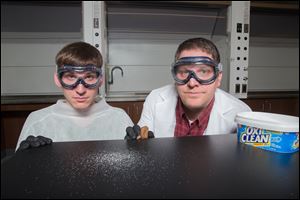
Ohio needs an opioid czar
3/2/2018
Noah Froelich, a Bowling Green State University junior, partnered with Travis Worst of the Center for the Future of Forensic Science and Department of Chemistry to find ways to protect against exposure to fentanyl.
Research from Bowling Green State University’s Center for the Future of Forensic Science has led to a breakthrough that will keep police and others safe from the effects of accidental exposure to the powerful drug fentanyl.
Students and faculty alarmed by the hazards posed for law enforcement, medical workers, and others who come into contact with the deadly opioid set out to find a way to neutralize the effects of the drug.
RELATED: BGSU researchers reduce danger of fentanyl exposure
Fentanyl, which is exponentially more potent than heroin, has become a street drug of choice as the opioid crisis rages on in Ohio. It can be easily absorbed through the skin, which makes it dangerous for first responders and others who come across it while working with opioid users.
In the past two years, 17 first responders have had adverse effects, including some overdoses, after accidentally coming into contact with the drug.
After tracking down previous research in China and experimenting with substances at their lab in Bowling Green, the researchers discovered that the common household cleaner OxiClean could work to neutralize the drug. In the majority of instances, they found the stain-removing detergent could remove all traces of fentanyl from surfaces.
When the scientists notified the state attorney general’s Bureau of Criminal Investigation of their findings, the agency sent an alert to more than 900 law enforcement agencies in the state, recommending authorities use OxiClean to clean surfaces where the drug might be found.
Click here to view more Blade editorials | Check out the Behind The Editorial series
This is the kind of research that is desperately needed in Ohio and elsewhere. The BGSU research team’s efforts fill a void left by the lack of leadership in Columbus. That’s where a centralized effort to tackle the state’s addiction epidemic should be a top priority.
Scientific breakthroughs, policy initiatives, and alerts about best practices and the latest strategies ought to be flying across the state from a dedicated state government opioid-policy office in Columbus, but it is not.
Ohio needs an opioid czar to coordinate work like the BGSU research with complementary initiatives around the state.
The opioid addiction crisis kills about 5,000 Ohioans each year with accidental overdoses. The risks to police, emergency medical technicians, and others is great, which is something BGSU’s pioneering researchers recognized. It is time for leaders in Columbus to recognize this too.
Follow @BladeOpinion on Twitter.